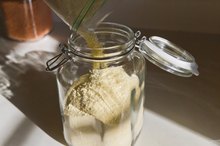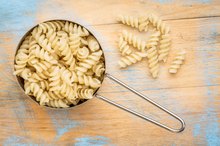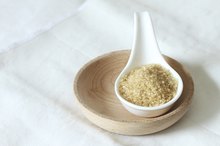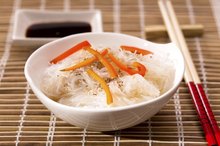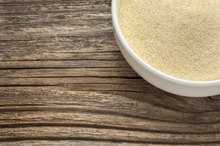What does fact checked mean?
At Healthfully, we strive to deliver objective content that is accurate and up-to-date. Our team periodically reviews articles in order to ensure content quality. The sources cited below consist of evidence from peer-reviewed journals, prominent medical organizations, academic associations, and government data.
The information contained on this site is for informational purposes only, and should not be used as a substitute for the advice of a professional health care provider. Please check with the appropriate physician regarding health questions and concerns. Although we strive to deliver accurate and up-to-date information, no guarantee to that effect is made.
Nutritional Value of Potato Starch & Corn Starch
Potato starch and cornstarch are, as their names imply, made from potato and corn respectively 5. With a flour-like texture, these powdered products can be added to baked goods, but are more commonly used as natural thickeners. Both potato and corn starch are relatively low in calories and contain little nutritional value other than their resistant starch content 5.
Defining Potato Starch and Cornstarch
Potato starch should not be confused with potato flour, as it is made from starch extracted from potatoes that undergoes a refining process 5. Potato flour is made from dehydrated cooked potatoes that are ground into a powder. Potato starch has little potato flavor 5. Cornstarch is made from the starchy portion of a corn kernel — the endosperm — and is sometimes also called corn flour.
Nutrition Facts
Cornstarch Vs. Flour Thickener
Learn More
A 1-tablespoon serving of potato starch has only 40 calories per serving, and 10 grams of carbohydrates and no dietary fiber 5. A 1-tablespoon serving of cornstarch has 30.5 calories per serving, a little over 7 grams of carbohydrates and a negligible amount of dietary fiber. Both starches are not a good source of essential minerals and vitamins.
Resistant Starch Content
Potato starch is known for being a good source of resistant starch, namely type 2 resistant starch 5. Cornstarch also contains some resistant starch, namely type 1 resistant starch. Resistant starch resists digestion — hence its name — and so it passes through your intestines undigested. Because of this, it is an excellent source of nutrition for the healthy bacteria in the colon, functioning as an important source of nutrition for you.
- Potato starch is known for being a good source of resistant starch, namely type 2 resistant starch 5.
Using Potato Starch and Cornstarch
What Starch Is in Popcorn?
Learn More
Both potato and cornstarch are used as natural thickeners, and they can be used in place of flour to thicken sauces, gravies, soups and stews. Cornstarch is a grain starch, so it thickens at a higher temperature than potato starch, which is a tuber starch 45. However, potato starch has a silkier texture to it and gives foods a glossier appearance, which may be especially appealing for sauces 5. Both starches can be added at the end of the cooking process, and clumps can easily be avoided by making a slurry — mix of starch and water — before mixing it in. **Because cornstarch withstands longer cooking times better, use it if you add thickener at the start of the cooking, and use potato starch if you are thickening at the end of the cooking 25.
Related Articles
References
- Naturally Good Food: Potato Starch and Potato Flour - What"s The Difference?
- The Kitchn: What's The Difference? Flour, Potato Starch, Cornstarch and Arrowroot
- Exploratorium: How Does Cornstarch Work?
- The Kitchn: Why Potato Starch Is My Favorite Thickener For Soups
- Bob's Red Mill: Potato Starch
- USDA National Nutrient Database: Cornstarch
- Comprehensive Reviews in Food Science and Food Safety: Resistant Starch -- A Review
- Al-Mana, N. M., & Robertson, M. D. (2018). Acute Effect of Resistant Starch on Food Intake, Appetite and Satiety in Overweight/Obese Males. Nutrients, 10(12), 1993. doi:10.3390/nu10121993
- Bindels, L. B., Segura Munoz, R. R., Gomes-Neto, J. C., Mutemberezi, V., Martínez, I., Salazar, N., … Ramer-Tait, A. E. (2017). Resistant starch can improve insulin sensitivity independently of the gut microbiota. Microbiome, 5(1), 12. doi:10.1186/s40168-017-0230-5
- Canani, R. B., Costanzo, M. D., Leone, L., Pedata, M., Meli, R., & Calignano, A. (2011). Potential beneficial effects of butyrate in intestinal and extraintestinal diseases. World journal of gastroenterology, 17(12), 1519–1528. doi:10.3748/wjg.v17.i12.1519
- Haub, M. D., Hubach, K. L., Al-Tamimi, E. K., Ornelas, S., & Seib, P. A. (2010). Different types of resistant starch elicit different glucose reponses in humans. Journal of nutrition and metabolism, 2010, 230501. doi:10.1155/2010/230501
- Brighenti, Furio et al. " Colonic fermentation of indigestible carbohydrates contributes to the second-meal effect." American Journal of Clinical Nutrition 83.4 (2006): 817-822.
- Cummings, JH. "The Large Intestine in Nutrition and Disease: (monograph), December 1996, ISBN 2-930151-02-1.
- Englyst, Klaus, et al. "Glycaemic index of cereal products explained by their content of rapidly and slowly available glucose." British Journal of Nutrition. 89 (2003):329-339.
- Englyst, Klaus and Englyst, Hans. "Carbohydrate Bioavailability." British Journal of Nutrition 94 (2005): 1-11.
- Higgins, Janine, et al. "Resistant starch consumption promotes lipid oxidation." Nutrition and Metabolism 1.8 (2004): 1743-7075.
- Higgins, Janine. "Resistant Starch: Metabolic Effects and Potential Health Benefits." Journal of AOAC International 87 (2004):761-8.
- Robertson, M.D. et al. "Prior Short-Term Consumption of Resistant Starch Enhances Postprandial Insulin Sensitivity in Healthy Subjects." Diabetologia 46 (2003): 659-665.
Writer Bio
Marie Dannie has been a professional journalist since 1991, specializing in nutrition and health topics. She has written for "Woman’s Own," the "Daily Mail," the "Daily Mirror" and the "Telegraph." She is a registered nutritionist and holds a Bachelor of Science degree with honors in food science from the University of Nottingham.
